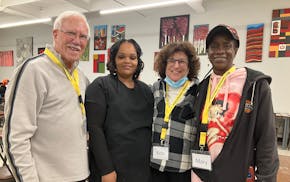Lindsay Petterson admits she's edgy these days. Elevators make her nervous, and she jumps "about a mile" if her car hits a pothole. When she nears a bridge, she crosses her fingers and says a little prayer.
It's been that way since Petterson, 25, survived the collapse of the 35W bridge.
On Wednesday, she eyed the ceiling of a cavernous conference room in Brooklyn Center and smiled sheepishly.
"Right now, the roof keeps making noises," she confided to a roomful of mental health workers, "and it's freaking me out a lot."
That came as no surprise to her audience, who had gathered to explore what they call "the psychological footprint" of disaster.
Eight months after the bridge disaster, the emotional strain is still taking a toll on survivors and those who tried to help them, said Jonathan Bundt, one of the conference organizers and a therapist and emergency-response adviser.
"The stages are very predictable," he said. But it may take weeks, months or longer for the symptoms to surface, making it difficult for some people to make the connection with the disaster.
At the conference, which was cosponsored by Hennepin County Medical Center, both survivors and first responders told stories of sleeplessness, nightmares and other problems.
Linda Koelman, a Minneapolis police chaplain who worked with families of the 13 people killed in the collapse, said she's had trouble concentrating ever since. "Every single day I think about the bridge, about the families," she said. At the same time, she said, she takes pride in the fact that she was able to help those families through the long wait to recover the bodies. "It was a horrible experience," she said. "But I would not give up that experience."
Chad Stencel, a Hennepin County paramedic, said he couldn't eat or sleep in the days after the disaster, and sought counseling to help him cope. Stencel, who was the first paramedic to reach the north end of the bridge, said he was haunted by the realization "that I couldn't save everybody. As a paramedic, you take that personally."
For Petterson, whose car plunged to the bottom of the river, the memories haunt her by day and night. "I've had nightmares about falling," she told the conference. "In my dreams, it's as real as it was that day."
Petterson remembers being trapped underwater and trying to escape, gasping for air and inhaling water instead. At one point, she remembers giving up, accepting she was going to die. "But then I started to float. I knew that I was either floating to heaven, or floating to the surface of the water." A construction worker pulled her to safety with a broom handle.
She spent five months in a back brace with a broken vertebrae, and has struggled to regain control over her life.
Today, she said, she knows that some people have grown weary hearing about the survivors' problems. "You're supposed to be over it by now," she said. But for many victims, that's simply unrealistic, she said.
"I'm hoping that things will continue to look up; they've started to," she said. "But again, I don't know what tomorrow will bring."
Maura Lerner • 612-673-7384
Orange crush: Boats packed with revelers tour Amsterdam canals to celebrate the king's birthday

